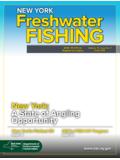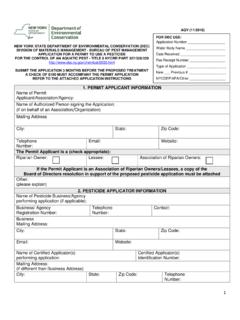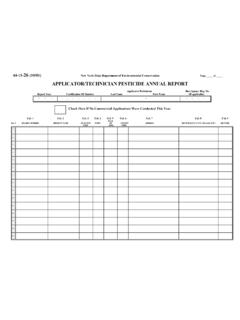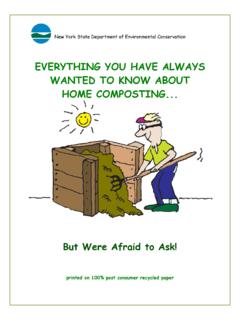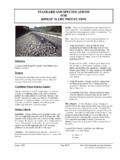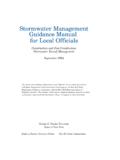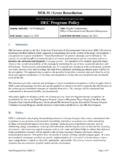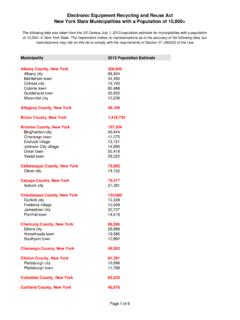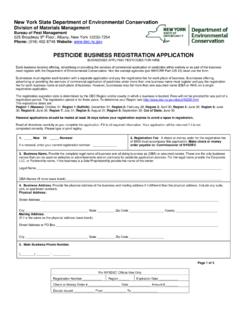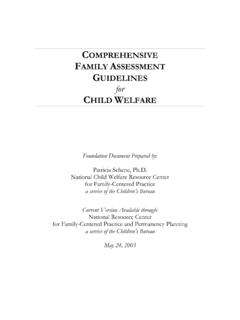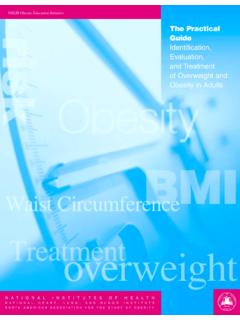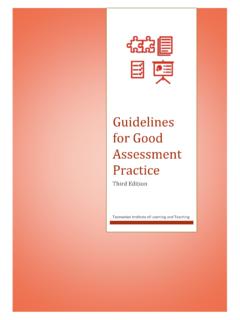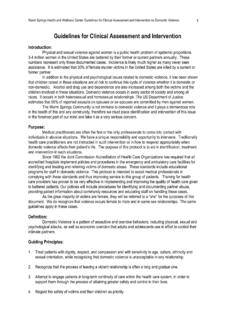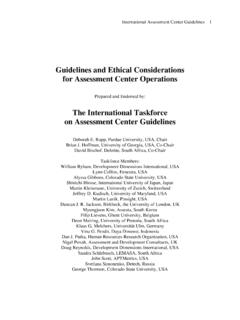Transcription of Guidance for Dam Engineering Assessment Reports
1 DOW Guidance FOR DAM Engineering Assessment Reports New York State Department of Environmental ConservationDEC Program Policy Issuing Authority: Mark Klotz Title: Guidance FOR DAM Engineering Assessment Date Issued: Latest Date Revised: NewOriginator: Alon Dominitz Dam Safety Section ** N O T I C E ** This document has been developed to provide Department staff with Guidance on how to ensure compliance with statutory and regulatory requirements, including case law interpretations, and to provide consistent treatment of similar situations. This document may also be used by the public to gain technical Guidance and insight regarding how the department staff may analyze an issue and factors in their consideration of particular facts and circumstances.
2 This Guidance document is not a fixed rule under the State Administrative Procedure Act section 102(2)(a)(I). Furthermore, nothing set forth herein prevents staff from varying from this Guidance as the specific facts and circumstances may dictate, provided staff's actions comply with applicable statutory and regulatory requirements. This document does not create any enforceable rights for the benefit of any party. Preliminary DRAFT Table of Contents I. Summary: .. 1 II. Policy: .. 1 III. Purpose and Background: .. 2 IV. Responsibility: .. 2 V. Procedure: .. 2 VI. Related References: .. 7 iGUIDANCE FOR DAM Engineering Assessment 1 I. Summary: Title 6 of New York Rules and Regulations, Part ( Part ) requires the preparation of an Engineering Assessment Report, which must be submitted to the New York State Department of Environmental Conservation ( Department ).
3 This policy provides Guidance to dam owners and engineers on the preparation of, and DEC staff on the review of, Engineering Assessment Reports pursuant to Part II. Policy: The life-cycle of a dam consists of several phases, starting with construction and initial filling and transitioning to alternating periods of normal operation and maintenance, repairs, and upgrades. This cycle continues until the dam is breached or removed, or fails. For a dam to continue to serve its intended function, it must be maintained. As conditions change over time, repairs and perhaps reconstruction and/ or upgrade of the dam, for example increasing the spillway capacity, may become necessary. A dam is a part of a dynamic system, with various forces continuously acting upon it, such as ice, flooding, earthquakes, erosion, animal burrowing, woody root penetration, and sediment accumulation.
4 Downstream developments can affect the hazard class of a dam, upstream developments can change the way the watershed behaves during runoff events, and science and technology evolve to modify best practices and regulatory criteria over time. The release of water stored by a dam in an uncontrolled manner represents a potential danger to downstream lives, property and the environment. As such, the dam owner must develop and implement a dam safety program. Part 673 requires that an owner s dam safety program that is appropriate to the dam s hazard classification. Those for Class C (High Hazard) or Class B (Intermediate Hazard) dams consist of periodic safety inspections and Engineering assessments, along with an Inspection and Maintenance Plan ( I&M Plan ) and an Emergency Action Plan ( EAP ).
5 An I&M Plan template is available on the Department s web site. Requirements for the preparation of an EAP are described in the Department s publication DOW Emergency Action Plans for Dams . Periodic safety inspections and Engineering assessments are intended to provide an independent review of an existing structure and the owner s dam safety program, identify any deficiencies or gaps in knowledge, and determine the steps and schedule necessary to correct the deficiencies. When deficiencies are identified, the dam owner must categorize them either as issues that can be resolved through regular or enhanced maintenance, or whether repairs and/or upgrades are required. Conditions requiring additional or continued monitoring should also be identified.
6 Maintenance is work involved in the routine or regular upkeep of a dam, and includes, for example, debris removal, mowing grass, cleaning trash racks, and exercising valves. Repairs or upgrades generally consist of more extensive or intrusive work, which if performed improperly could endanger the structure, and therefore must be performed under the supervision of a professional engineer ( PE ), in accordance with a formal design, and require a dam safety permit issued by the Department through its Division of Environmental Permits, in pursuant to Parts 608 and 621. Although maintenance does not require a Dam Safety permit, it could require other types of permits, such as a Construction Stormwater permit, from the DEC. Guidance FOR DAM Engineering Assessment 2 Safety inspections and Engineering assessments include many of the components that would be required as part of a permit application for repair or upgrading of the dam.
7 The difference is that regular inspections and assessments are an evaluation of the existing structure against current dam safety criteria, whereas the Engineering Design Report, plans and specifications required for a permit must evaluate the proposed repairs and/or upgrades to the structure. In either case, the dam and appurtenant structures should be considered as part of an integrated system, and must function together to safely fulfill their water impounding function. III. Purpose and Background: It is the purpose of this Guidance to inform owners, engineers, and DEC staff regarding the procedures, content, and format for dam safety Engineering Assessment Reports as required by 6 NYCRR Part 673. Part 673 requires owners of Hazard Class B (Intermediate Hazard) and Class C (High Hazard) dams, and, at the Department s discretion, dams assigned a Condition Rating of Unsafe or Unsound, to perform an Engineering Assessment of their dam on a regular basis.
8 This Guidance represents the professional judgment of the Department s Dam Safety Section s engineers. The Guidance is applicable for the average dam in an average situation. Where unusual conditions exist, it is the duty of the dam owner s engineer to highlight any deviation from the Department s Guidance and provide the specific Engineering rationale for said deviation. Cost alone is not an acceptable rationale. IV. Responsibility: The dam safety program within the Bureau of Flood Protection and Dam Safety will interpret and maintain this policy. V. Procedure: The Engineering Assessment Report must, at a minimum, include the following: 1. Hazard classification evaluation 2. Complete Safety Inspection 3. Evaluation of the dam s spillway capacity 4.
9 Evaluation of the dam s structural stability 5. Evaluate Outlet works (reservoir drain) capacity 6. Review of the dam s Emergency Action Plan, and 7. Provide a conclusion as to whether the dam is in conformance with current dam regulations and safety Guidance . The tasks normally associated with performing a dam safety Engineering Assessment can be divided as follows: A. File review B. On-site Engineering Inspection and Investigation Guidance FOR DAM Engineering Assessment 3 C. Engineering review, calculations, and conclusions D. Engineering Assessment Report Generation E. File report with Department and retain a copy with owner s records The Assessment should determine the condition of the dam relative to the appropriate safety criteria.
10 It should identify deficiencies and recommend, as appropriate, remedial repairs, operational restrictions, monitoring, and/or modifications. The Assessment should also identify any analyses and/or studies needed to assess and determine solutions to identified deficiencies. The Engineering Assessment must be performed by a professional engineer registered to practice in New York State and possessing appropriate experience in evaluation of dams of type, size, and location to be assessed. The dam Engineering Assessment Report must be submitted to the Department in accordance with the schedule detailed in Part The owner must retain a copy of the dam Engineering Assessment Report with their records of the dam. A. Records Review Perform a review of existing dam information.
